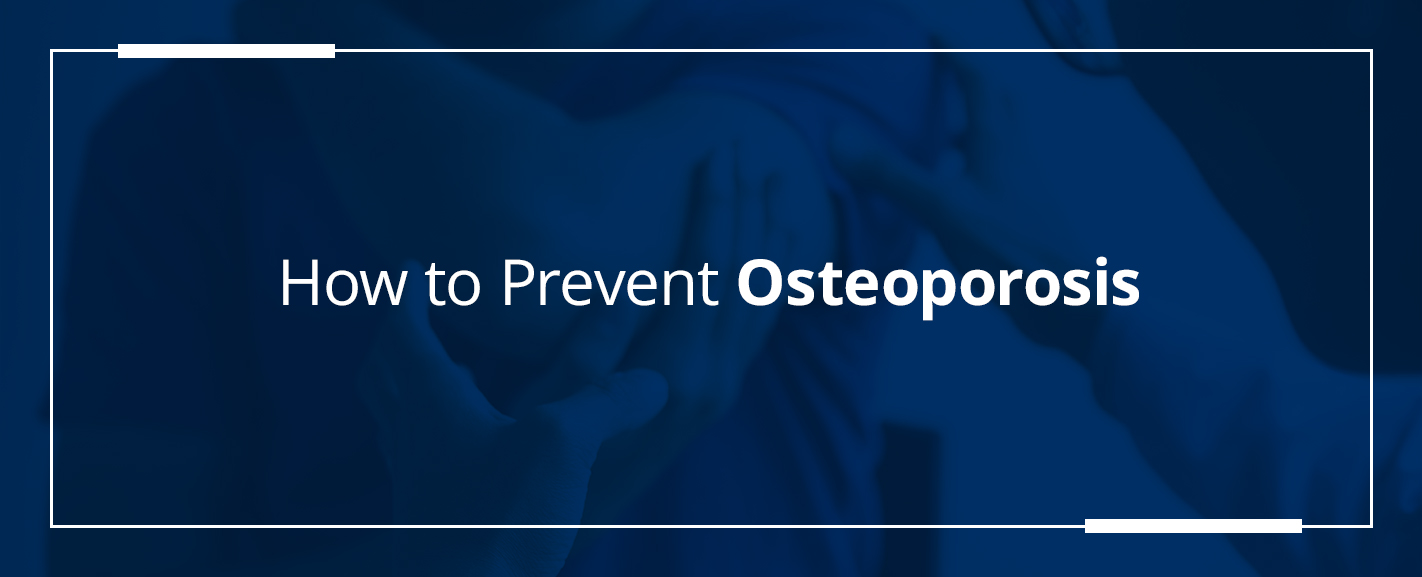
Approximately 10.2 million Americans are living with osteoporosis. Perhaps this is why many people mistakenly believe that osteoporosis — a condition that occurs when the body loses a significant amount of bone mineral density — is a normal part of aging. Though everyone loses some bone density as they age, losing density at a rapid rate over a short period of time can have debilitating consequences.
Developing low bone mass isn’t inevitable, even if you’re considered to be high risk because of genetics or another health condition. There are steps you can take to prevent osteoporosis or slow its progression if you already have it. To understand how you can protect your bones from losing density and prevent breaks, it’s important to understand what osteoporosis is and how it affects the human body.
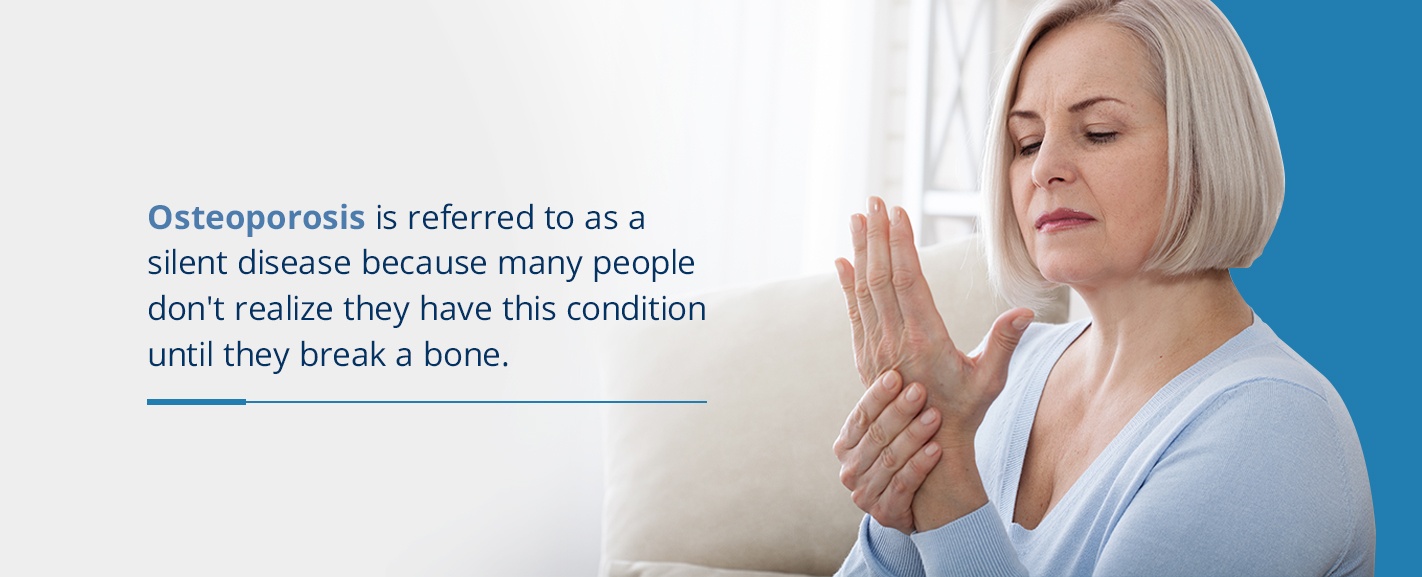
What Is Osteoporosis?
Osteoporosis occurs when a person’s bones lose calcium more quickly than their body can replace it. When bones become incapable of producing the necessary amount of calcium, they lose density and become brittle and weak. Bones in this condition are more susceptible to a fracture. Individuals who have osteoporosis most commonly experience breaks in the spine, wrists and hip bones.
Osteoporosis is referred to as a silent disease because many people don’t realize they have this condition until they break a bone. The problem with this method of diagnosis is that the condition may have been progressing for years before a break happens. If a break is due to brittle bones, a full recovery can be more challenging.
Osteoporosis is most commonly found in women. In fact, 50% of women over the age of 50 will experience a break due to osteoporosis. But men can also develop this condition as they age. Approximately 25% of all fractures related to osteoporosis happen in men.
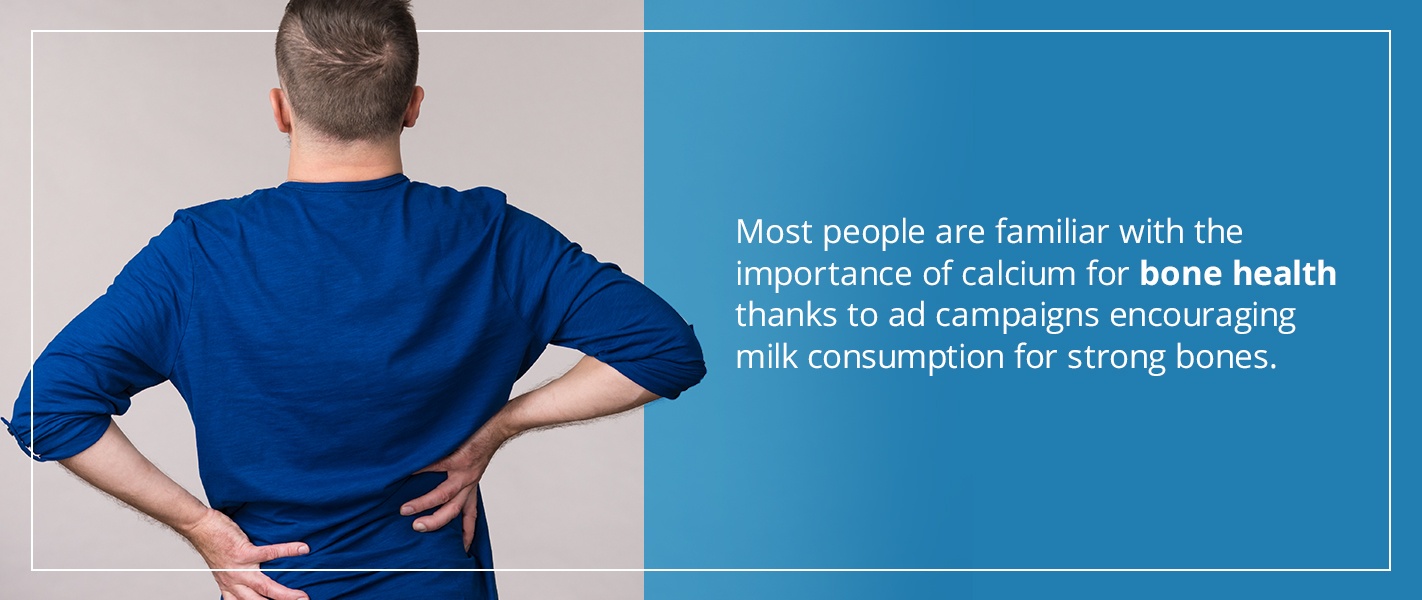
What Causes Osteoporosis?
During the first 30 years of your life, your body is constantly working to break down bone tissue and build it back up. This creates stronger, more dense bones. This is a major reason why good nutrition is essential for children. What we eat or don’t eat plays a significant role in our body’s ability to build up and maintain bone density.
Bones store calcium and rely on calcium and vitamin D for building and maintaining strength. Most people are familiar with the importance of calcium for bone health thanks to ad campaigns encouraging milk consumption for strong bones. Vitamin D also plays an essential role in bone health. The body uses vitamin D to extract calcium from food so it can be absorbed and used throughout the body. Without vitamin D, all the calcium in the world would not be enough.
In their early 30s, adults stop producing bone mass. At that point, the body’s goal is to maintain what’s already there. Proper nutrition and exercise can go a long way toward maintaining bone density and preventing bones from becoming brittle and fragile. Once an adult is over the age of 50, their body naturally begins to shed some of its bone density. As a person ages — or after a significant injury to a bone — the human body may be incapable of producing enough calcium and vitamin D to maintain a bone’s density. When bones become less dense, they become more brittle and break easier.
Women tend to experience this earlier than men. This is because female bones are naturally less dense than male bones, and estrogen levels drop after menopause, leaving a woman’s bones more vulnerable. As men age, their bodies also experience certain changes that can leave them vulnerable to this condition.
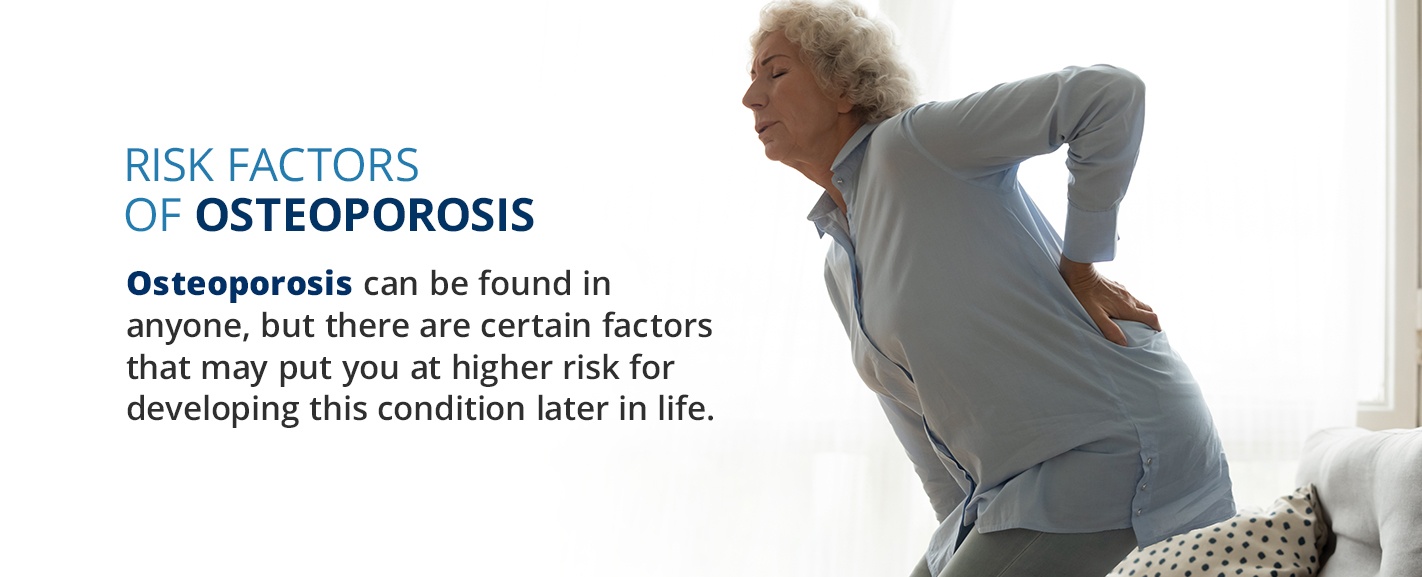
Risk Factors of Osteoporosis
Osteoporosis can be found in anyone, but there are certain factors that may put you at higher risk for developing this condition later in life. Women are especially at risk, particularly if they have:
- Previously broken a bone
- A family history of osteoporosis
- Experienced extended periods of bed rest or inactivity
- Completed menopause
- Experienced early menopause due to removal of their ovaries prior to natural menopause
- Smoked
- Failed to get enough vitamin D or calcium throughout their lives
- Taken certain medicines for an extended time, especially corticosteroids
- Not exercised enough
Women also are at higher risk for osteoporosis the older they get. When a woman experiences menopause, she may have rapid loss of bone density at that time, due to her body’s decrease in estrogen. The rapid rate of density loss will eventually slow down, but it will continue for the rest of her life.
Men may not experience a significant loss in bone density as early as women because men’s bones are naturally denser. However, by the time men and women reach the age of 70, their bodies are losing the same amount of bone density. Many of the risk factors for women are also risk factors for men, especially if a man doesn’t get enough calcium or has been a lifelong smoker. Men have some additional risk factors, including low testosterone levels.
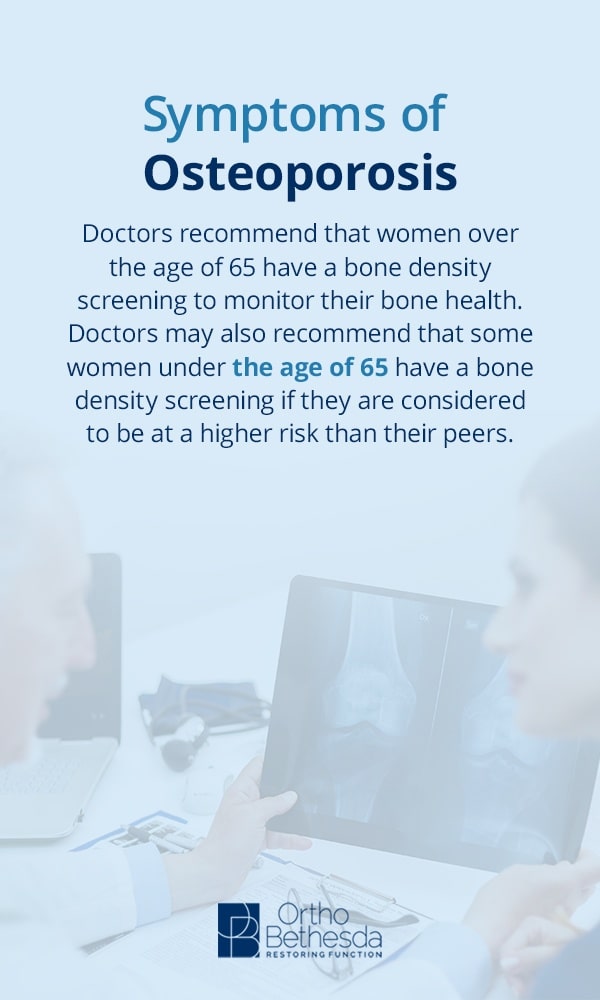
Symptoms of Osteoporosis
Doctors recommend that women over the age of 65 have a bone density screening to monitor their bone health. Doctors may also recommend that some women under the age of 65 have a bone density screening if they are considered to be at a higher risk than their peers. There are a few less common symptoms and signs that your bone density may be decreasing, including:
- Stooped posture or loss of height
- Back pain
- A bone fracture that occurs more easily than it should
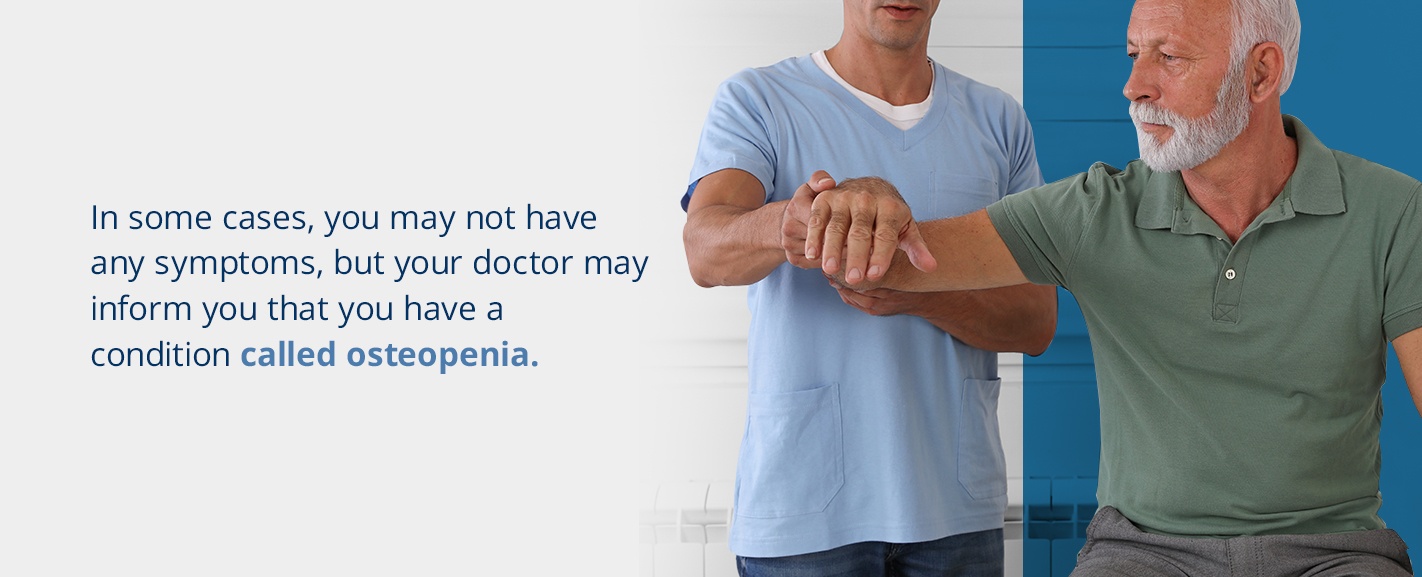
Diagnosis of Osteoporosis
In some cases, you may not have any symptoms, but your doctor may inform you that you have a condition called osteopenia. This means your body has started losing bone mass. This should be considered a warning sign that osteoporosis is possible, however, it doesn’t mean the condition is already present. At this phase, you can’t regain all that’s been lost, but you can take steps to prevent further loss of bone mass and avoid breaks.
Osteoporosis is typically diagnosed through bone density screenings. This screening can measure the density of your bones and give your doctor a more accurate picture of your risk levels for developing osteoporosis. Early detection is key to preventing further loss of bone density and breaks.
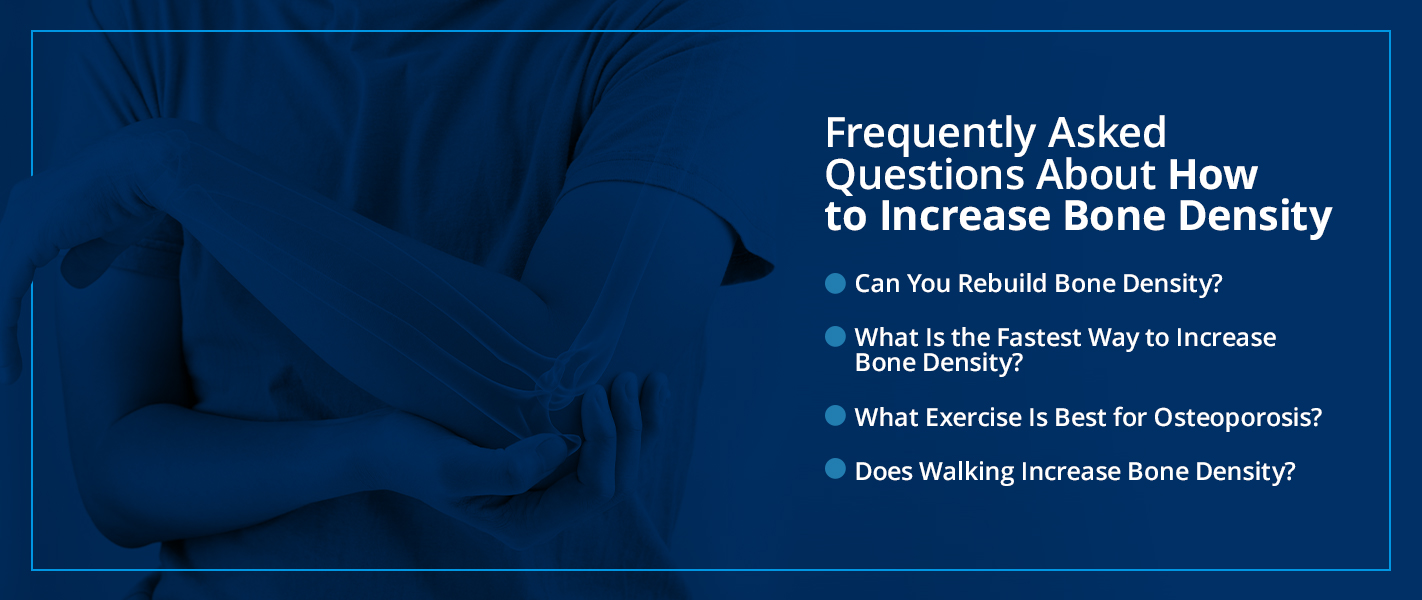
Frequently Asked Questions About How to Increase Bone Density
The following answer some frequently asked questions concerning how to improve bone health and prevent osteoporosis:
1. Can You Rebuild Bone Density?
Older adults typically cannot do much to regain what’s already been lost. But one thing you can do to maintain bone health and prevent or slow the progression of osteoporosis is work to increase your bone density. Although most adults can’t increase bone density in large amounts, there are things you can do to build and maintain bone density throughout your life.
2. What Is the Fastest Way to Increase Bone Density?
Weight-bearing exercise is the quickest way to boost bone density. A weight-bearing exercise is one that requires your legs and feet to bear the full weight of your body. Many people mistakenly believe they have to join a gym or be in great shape to engage in weight-bearing exercises. The truth is you don’t need a gym membership or fancy workout equipment to get the exercise your body and bones need. In fact, you don’t even have to leave your home to begin incorporating these exercises into your daily routine.
You should always consult with your doctor before beginning a new exercise routine. This is especially important if you have other underlying medical conditions or your osteoporosis is advanced enough that improper exercise could put you at risk. A doctor or qualified physical therapist can help you identify the right exercises for your personal needs and build a safe routine that will decrease your risk of falls and broken bones.
3. What Exercise Is Best for Osteoporosis?
Depending on your age and overall health, your doctor may recommend either low- or high-impact osteoporosis prevention exercises:
- Low-impact weight-bearing exercises: Common examples of low-impact exercises your doctor may recommend include yoga, climbing stairs, low-impact aerobics, Pilates, water aerobics and tai chi.
- High-impact weight-bearing exercises: Examples of high-impact exercises your doctor could suggest include hiking, indoor or outdoor running, stair climbing, dancing and tennis.
Strength training is also important. Extreme strength training isn’t necessary for increasing bone density and maintaining muscle strength. Moderate strength training can be done at home with items you can find around your house. Simple options for at-home strength training include pushups, situps or squats. You can also try exercises with elastic resistance bands. Even lifting soup cans or bags of groceries can be beneficial.
An additional benefit of these exercises is that they improve balance and flexibility. Improved balance and flexibility reduce the likelihood you will fall and break a bone. If you aren’t ready to dive into an elaborate exercise routine, that’s OK. The important thing is to stay active and improve your muscle strength. Simple activities like gardening are an easy, fun way to build your strength.
4. Does Walking Increase Bone Density?
Walking can contribute to improved bone health with the right routine. When most people take a walk, they walk at the same pace for a consistent amount of time. To get the bone-building benefits of walking, change up your routine by incorporating wrist or ankle weights and change your route to include hills or increase your pace.
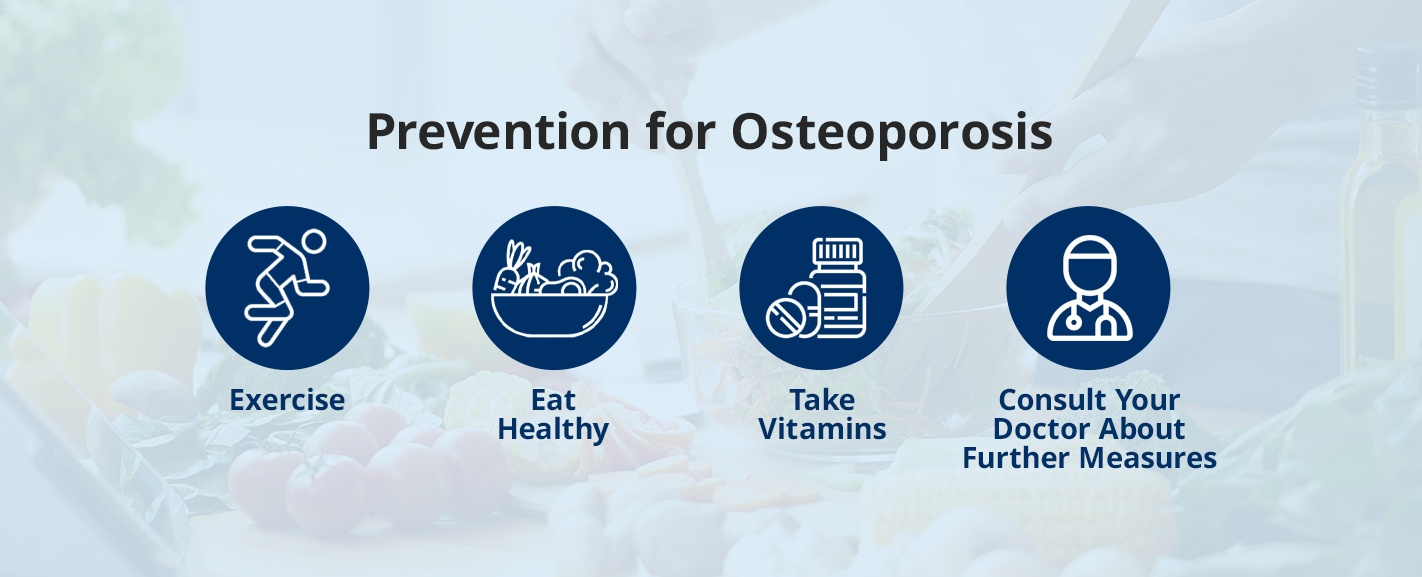
Prevention for Osteoporosis
There are certain risk factors of osteoporosis that you can’t control, such as age, gender and a decline in hormones. But osteoporosis isn’t inevitable. The effects of this condition can be avoided by implementing healthy habits early on in life. The following are some ways you can prevent osteoporosis naturally:
1. Exercise
Creating and maintaining an active lifestyle should be a priority beginning early on in life. This is one of the reasons why pediatricians place a high value on encouraging children to be active. Staying active from a young age plays a major role in building up your body’s bone density. Although the adult body doesn’t increase bone density at the rapid rate of a child, maintaining an active lifestyle and incorporating exercise into your daily routine helps to prevent a significant loss in bone density.
As you age, you can protect the bone density you have and prevent a rapid decline. Exercise helps you do this in several ways. First, weight-bearing exercises build and maintain muscle. Strong muscles help you maintain good balance and prevent falls, which can cause bone breaks. Exercise also helps older adults manage their weight. Adults who are underweight, especially post-menopausal women, are at a higher risk of developing osteoporosis.
If you don’t want to join a gym or commit to an intense workout routine, look for ways to incorporate movement into your daily life. Schedule time for long walks with friends. Plant a vegetable garden. Lift soup cans while you watch the news. When you choose things you love for exercise, you’re more likely to remain consistent and see results.
2. Eat Healthy
Healthy eating is another one of the best things you can do to prevent osteoporosis. A diet rich in protein, vitamin D and calcium will nourish your bones and prevent significant density loss as you age. Overall, eating a healthy daily diet full of fruits, vegetables, dairy and fish is the best osteoporosis prevention diet.
Examples of what you should eat to prevent osteoporosis fall into categories of foods that are high in calcium and vitamin D, as well as foods that are generally nutritious. Some foods that are high in calcium include:
- Fat-free or low-fat dairy products
- Dark green veggies like broccoli, kale, bok choy or collard greens
- Salmon with bones and sardines
- Foods that have been fortified with calcium, such as cereal and soy milk
Foods that are higher in vitamin D include:
- Foods that have been fortified with vitamin D, such as cereal and orange juice
- Egg yolks and cheese
- Beef liver
- Fatty fish, such as mackerel, tuna and salmon
Other important nutrients include magnesium, potassium and vitamin C. To get these nutrients, you can incorporate other foods into your diet, such as:
- Sweet potatoes
- Citrus fruits, such as pink grapefruit or navel oranges
- Fresh figs
- Almond butter
- Prunes
- Molasses
If you haven’t been following a healthy diet before now, it is not too late. While you won’t necessarily be able to build back the bone density that’s been lost, you can prevent further loss by changing your eating habits to incorporate nutritious foods. Talk with your doctor to create a diet plan high in nutrients that are essential for bone health.
3. Take Vitamins
If you are consuming a healthy diet, you may find it easy to get enough calcium. However, it can be difficult to get enough vitamin D from diet alone. Many adults also don’t consume enough high-calcium foods on a daily basis. If your diet is lacking in these nutrients or you are genetically predisposed to osteoporosis, you may benefit from incorporating supplements into your daily routine.
Women over 50 have especially been known to benefit from calcium supplements in the right doses. There is some debate over the effectiveness of calcium supplements in women and the amount of calcium you should consume each day, so always talk to your doctor first.
While vitamins and other supplements can provide some nutritional benefits, remember they are not an effective prevention method on their own. However, balancing proper levels of nutrients in your body can help maintain the bone density that is already there and slow down the rate of loss as you age.
4. Consult Your Doctor About Further Measures
Your doctor may recommend one or more of the following health measures to help prevent osteoporosis:
- Take medication: If you are at a high risk for osteoporosis or you are in the early stages of this condition, there are medications that can help your body maintain bone density and slow the progression of this condition. Speak with your doctor about options.
- Stop smoking: On average, people who smoke have a lower bone density than people who don’t smoke. This is one of a range of medical conditions that can be exacerbated by smoking. Talk to your doctor about how to safely and quickly stop smoking today.
- Limit alcohol consumption: There’s nothing wrong with the occasional cocktail or glass of wine. In fact, some research has found there are health benefits to consuming red wine in moderation. But adults who consume larger amounts of alcohol are at a higher risk for developing osteoporosis. Limit your alcohol consumption to no more than two drinks per day, and aim to have at least two days a week when you don’t drink at all.
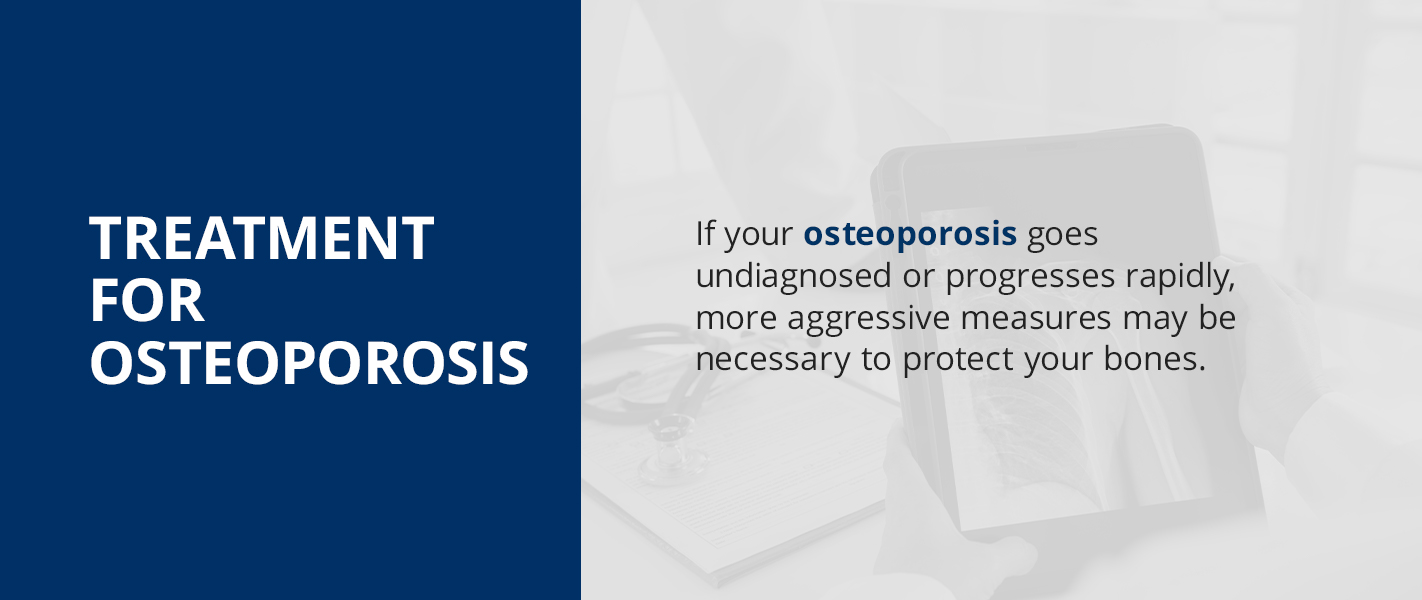
Treatment for Osteoporosis
The type of treatment you receive for osteoporosis will depend on the progression of the condition, when it is diagnosed and your projected risk factors for the future. If caught early on, doctors will often recommend that a patient make significant lifestyle changes that decrease the rate of bone density loss and improve their overall strength and coordination. The emphasis will be on maintaining the bone that’s already there and building up the body’s balance and stability to reduce the risk of falling and breaking bones.
If your osteoporosis goes undiagnosed or progresses rapidly, more aggressive measures may be necessary to protect your bones. Adults with osteoporosis have a higher risk of breaking their hip or fracturing their spine, which can lead to other serious and debilitating health conditions. Medications may be used to slow down the progression of bone deterioration. Building strong bones and muscles, as well as preventing falls, also becomes a major priority.
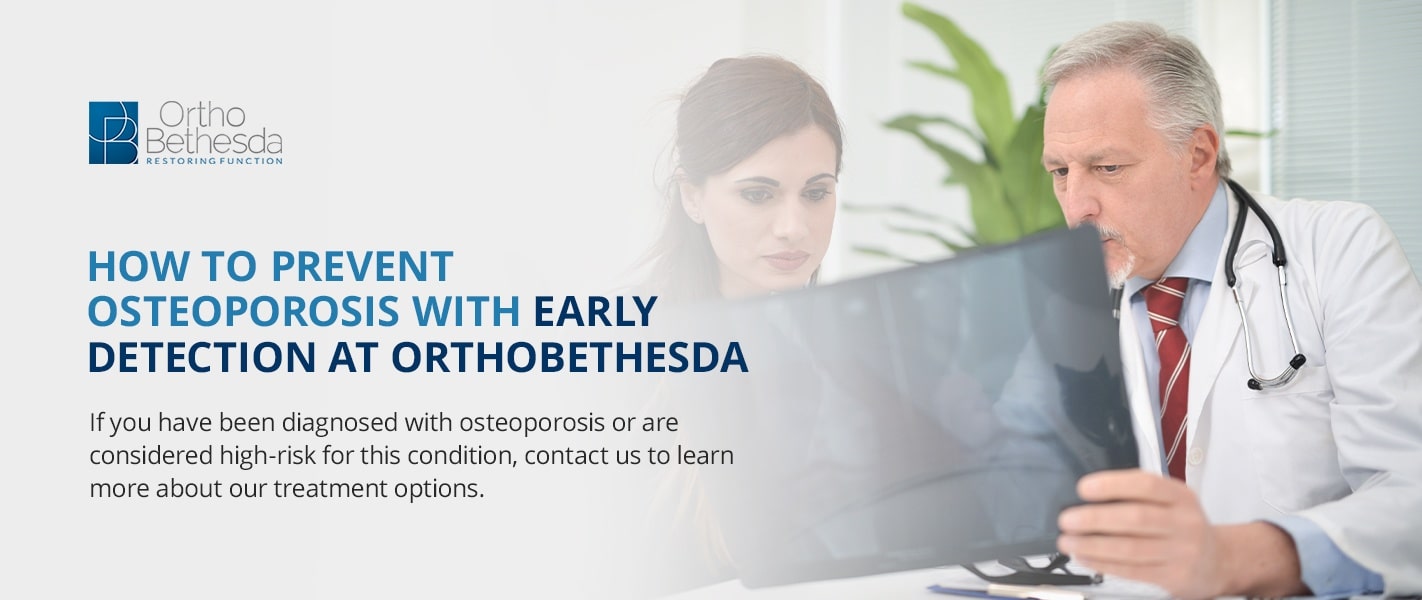
How to Prevent Osteoporosis With Early Detection at OrthoBethesda
Early detection and treatment of osteoporosis are key to successfully managing this condition. The earlier a doctor identifies a decrease in bone density, the sooner they can help patients prevent devastating and potentially life-threatening injuries.
The doctors and staff at OrthoBethesda are committed to helping patients navigate the challenges of detection and prevention of osteoporosis. Our goal is to diagnose osteoporosis early, but even if your condition has progressed, we’re ready to design a treatment plan that can protect your body and improve your overall quality of life.
If you have been diagnosed with osteoporosis or are considered high-risk for this condition, contact us to learn more about our treatment options.
Related Content
- Arthritis vs. Arthrosis
- Common Types of Arthritis Explained
- Types of Bursitis
- Consequences of Delaying Medical and Surgical Care
- Winter Injury Prevention Guide
- Inpatient Surgery vs. Outpatient Surgery
- Why Your Joints Are Cracking
- What Does an Orthopedic Doctor Do?
- Types of Common Outpatient Surgeries
- What to Wear and What Not to Wear During Surgery
